Essay on Chindits and Their Contribution
VerifiedAdded on 2022/09/09
|7
|1890
|19
AI Summary
Contribute Materials
Your contribution can guide someone’s learning journey. Share your
documents today.
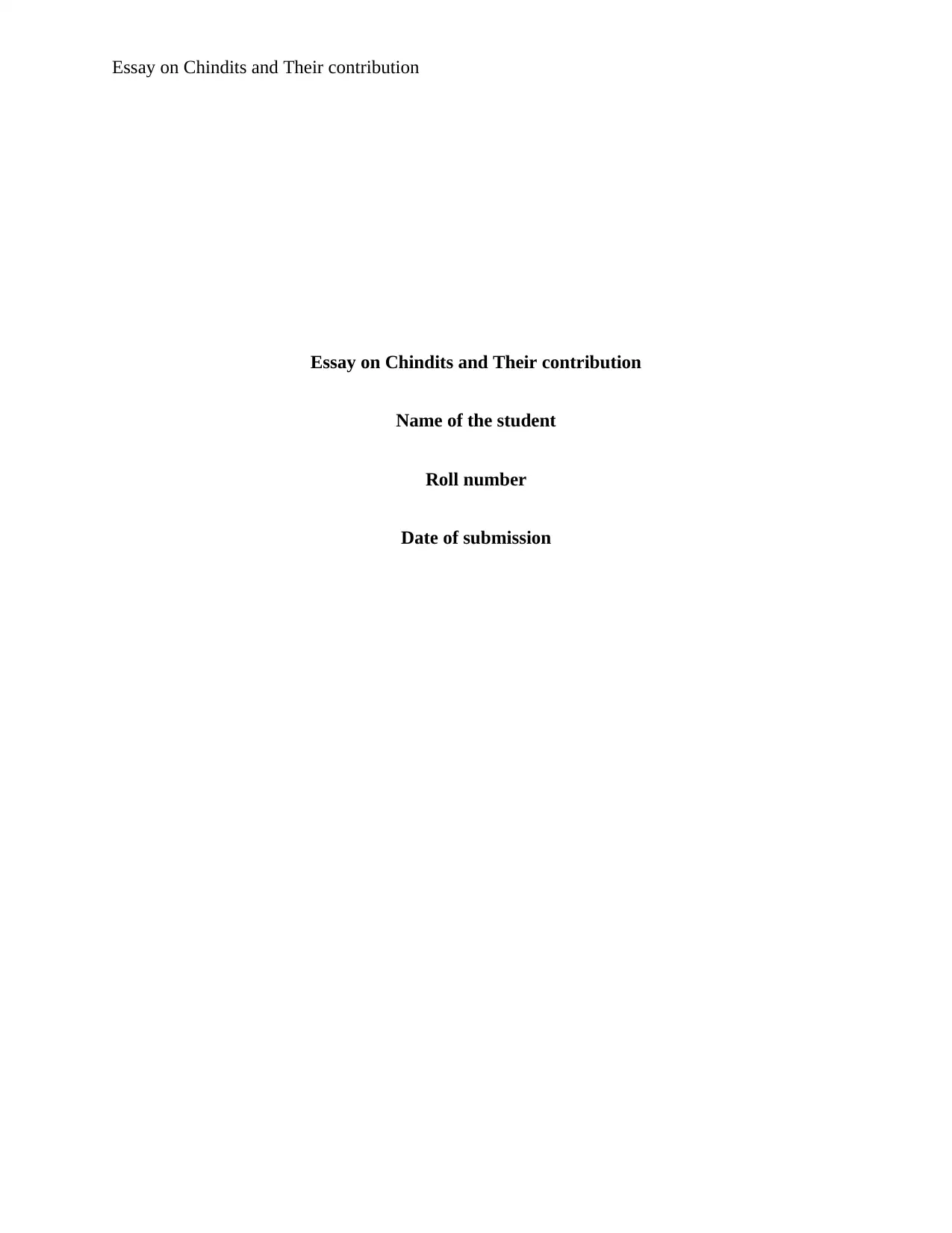
Essay on Chindits and Their contribution
Essay on Chindits and Their contribution
Name of the student
Roll number
Date of submission
Essay on Chindits and Their contribution
Name of the student
Roll number
Date of submission
Secure Best Marks with AI Grader
Need help grading? Try our AI Grader for instant feedback on your assignments.
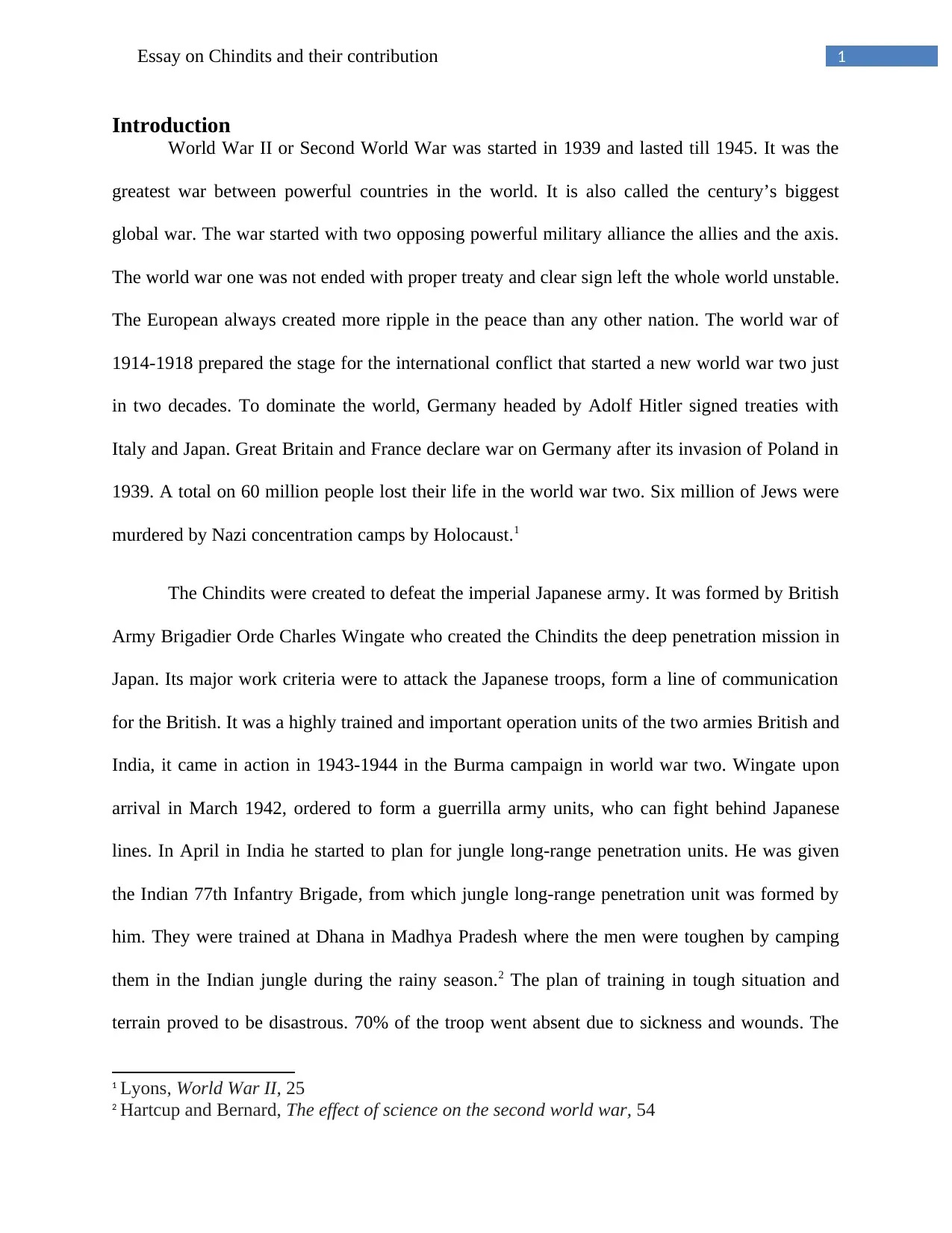
1Essay on Chindits and their contribution
Introduction
World War II or Second World War was started in 1939 and lasted till 1945. It was the
greatest war between powerful countries in the world. It is also called the century’s biggest
global war. The war started with two opposing powerful military alliance the allies and the axis.
The world war one was not ended with proper treaty and clear sign left the whole world unstable.
The European always created more ripple in the peace than any other nation. The world war of
1914-1918 prepared the stage for the international conflict that started a new world war two just
in two decades. To dominate the world, Germany headed by Adolf Hitler signed treaties with
Italy and Japan. Great Britain and France declare war on Germany after its invasion of Poland in
1939. A total on 60 million people lost their life in the world war two. Six million of Jews were
murdered by Nazi concentration camps by Holocaust.1
The Chindits were created to defeat the imperial Japanese army. It was formed by British
Army Brigadier Orde Charles Wingate who created the Chindits the deep penetration mission in
Japan. Its major work criteria were to attack the Japanese troops, form a line of communication
for the British. It was a highly trained and important operation units of the two armies British and
India, it came in action in 1943-1944 in the Burma campaign in world war two. Wingate upon
arrival in March 1942, ordered to form a guerrilla army units, who can fight behind Japanese
lines. In April in India he started to plan for jungle long-range penetration units. He was given
the Indian 77th Infantry Brigade, from which jungle long-range penetration unit was formed by
him. They were trained at Dhana in Madhya Pradesh where the men were toughen by camping
them in the Indian jungle during the rainy season.2 The plan of training in tough situation and
terrain proved to be disastrous. 70% of the troop went absent due to sickness and wounds. The
1 Lyons, World War II, 25
2 Hartcup and Bernard, The effect of science on the second world war, 54
Introduction
World War II or Second World War was started in 1939 and lasted till 1945. It was the
greatest war between powerful countries in the world. It is also called the century’s biggest
global war. The war started with two opposing powerful military alliance the allies and the axis.
The world war one was not ended with proper treaty and clear sign left the whole world unstable.
The European always created more ripple in the peace than any other nation. The world war of
1914-1918 prepared the stage for the international conflict that started a new world war two just
in two decades. To dominate the world, Germany headed by Adolf Hitler signed treaties with
Italy and Japan. Great Britain and France declare war on Germany after its invasion of Poland in
1939. A total on 60 million people lost their life in the world war two. Six million of Jews were
murdered by Nazi concentration camps by Holocaust.1
The Chindits were created to defeat the imperial Japanese army. It was formed by British
Army Brigadier Orde Charles Wingate who created the Chindits the deep penetration mission in
Japan. Its major work criteria were to attack the Japanese troops, form a line of communication
for the British. It was a highly trained and important operation units of the two armies British and
India, it came in action in 1943-1944 in the Burma campaign in world war two. Wingate upon
arrival in March 1942, ordered to form a guerrilla army units, who can fight behind Japanese
lines. In April in India he started to plan for jungle long-range penetration units. He was given
the Indian 77th Infantry Brigade, from which jungle long-range penetration unit was formed by
him. They were trained at Dhana in Madhya Pradesh where the men were toughen by camping
them in the Indian jungle during the rainy season.2 The plan of training in tough situation and
terrain proved to be disastrous. 70% of the troop went absent due to sickness and wounds. The
1 Lyons, World War II, 25
2 Hartcup and Bernard, The effect of science on the second world war, 54
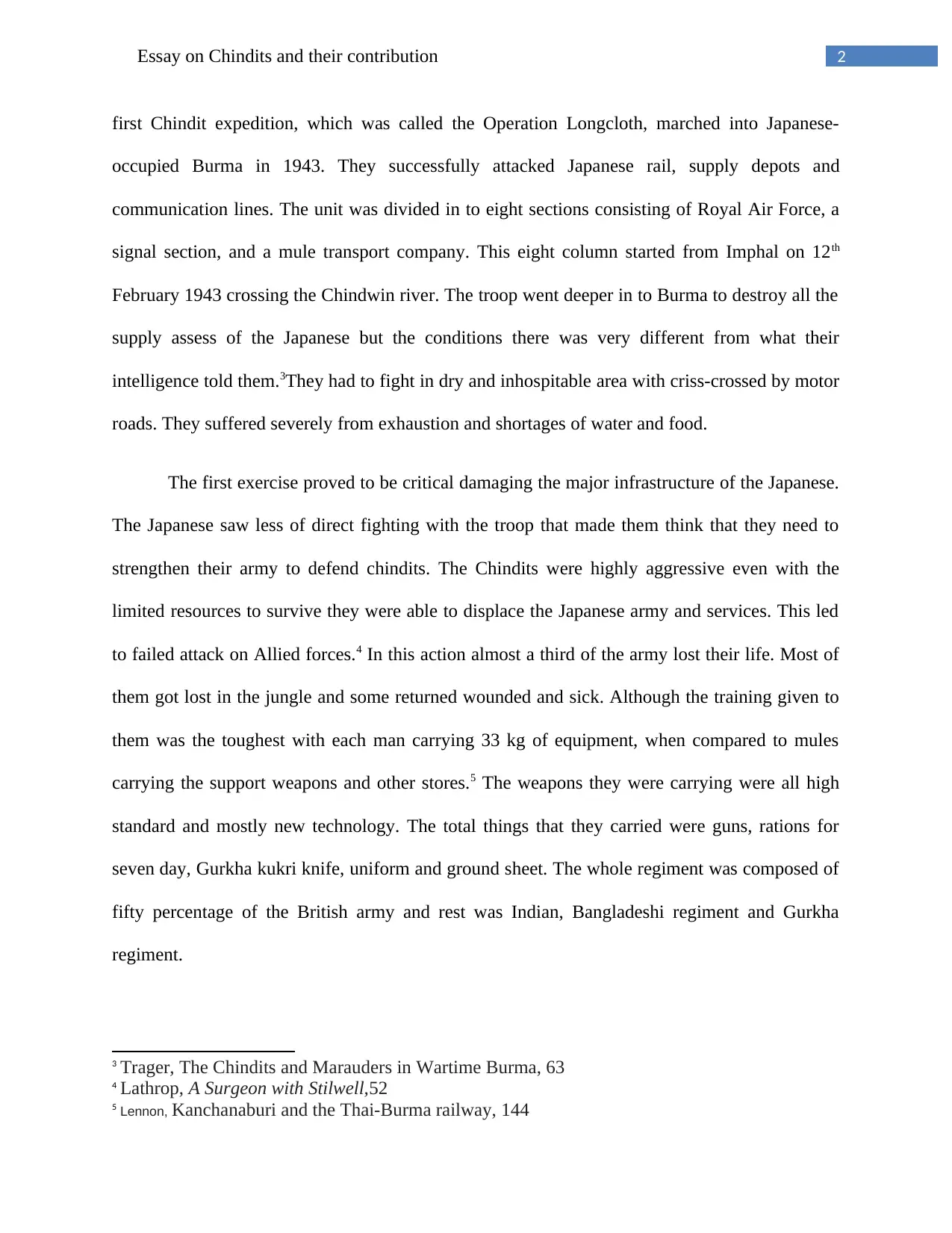
2Essay on Chindits and their contribution
first Chindit expedition, which was called the Operation Longcloth, marched into Japanese-
occupied Burma in 1943. They successfully attacked Japanese rail, supply depots and
communication lines. The unit was divided in to eight sections consisting of Royal Air Force, a
signal section, and a mule transport company. This eight column started from Imphal on 12th
February 1943 crossing the Chindwin river. The troop went deeper in to Burma to destroy all the
supply assess of the Japanese but the conditions there was very different from what their
intelligence told them.3They had to fight in dry and inhospitable area with criss-crossed by motor
roads. They suffered severely from exhaustion and shortages of water and food.
The first exercise proved to be critical damaging the major infrastructure of the Japanese.
The Japanese saw less of direct fighting with the troop that made them think that they need to
strengthen their army to defend chindits. The Chindits were highly aggressive even with the
limited resources to survive they were able to displace the Japanese army and services. This led
to failed attack on Allied forces.4 In this action almost a third of the army lost their life. Most of
them got lost in the jungle and some returned wounded and sick. Although the training given to
them was the toughest with each man carrying 33 kg of equipment, when compared to mules
carrying the support weapons and other stores.5 The weapons they were carrying were all high
standard and mostly new technology. The total things that they carried were guns, rations for
seven day, Gurkha kukri knife, uniform and ground sheet. The whole regiment was composed of
fifty percentage of the British army and rest was Indian, Bangladeshi regiment and Gurkha
regiment.
3 Trager, The Chindits and Marauders in Wartime Burma, 63
4 Lathrop, A Surgeon with Stilwell,52
5 Lennon, Kanchanaburi and the Thai-Burma railway, 144
first Chindit expedition, which was called the Operation Longcloth, marched into Japanese-
occupied Burma in 1943. They successfully attacked Japanese rail, supply depots and
communication lines. The unit was divided in to eight sections consisting of Royal Air Force, a
signal section, and a mule transport company. This eight column started from Imphal on 12th
February 1943 crossing the Chindwin river. The troop went deeper in to Burma to destroy all the
supply assess of the Japanese but the conditions there was very different from what their
intelligence told them.3They had to fight in dry and inhospitable area with criss-crossed by motor
roads. They suffered severely from exhaustion and shortages of water and food.
The first exercise proved to be critical damaging the major infrastructure of the Japanese.
The Japanese saw less of direct fighting with the troop that made them think that they need to
strengthen their army to defend chindits. The Chindits were highly aggressive even with the
limited resources to survive they were able to displace the Japanese army and services. This led
to failed attack on Allied forces.4 In this action almost a third of the army lost their life. Most of
them got lost in the jungle and some returned wounded and sick. Although the training given to
them was the toughest with each man carrying 33 kg of equipment, when compared to mules
carrying the support weapons and other stores.5 The weapons they were carrying were all high
standard and mostly new technology. The total things that they carried were guns, rations for
seven day, Gurkha kukri knife, uniform and ground sheet. The whole regiment was composed of
fifty percentage of the British army and rest was Indian, Bangladeshi regiment and Gurkha
regiment.
3 Trager, The Chindits and Marauders in Wartime Burma, 63
4 Lathrop, A Surgeon with Stilwell,52
5 Lennon, Kanchanaburi and the Thai-Burma railway, 144
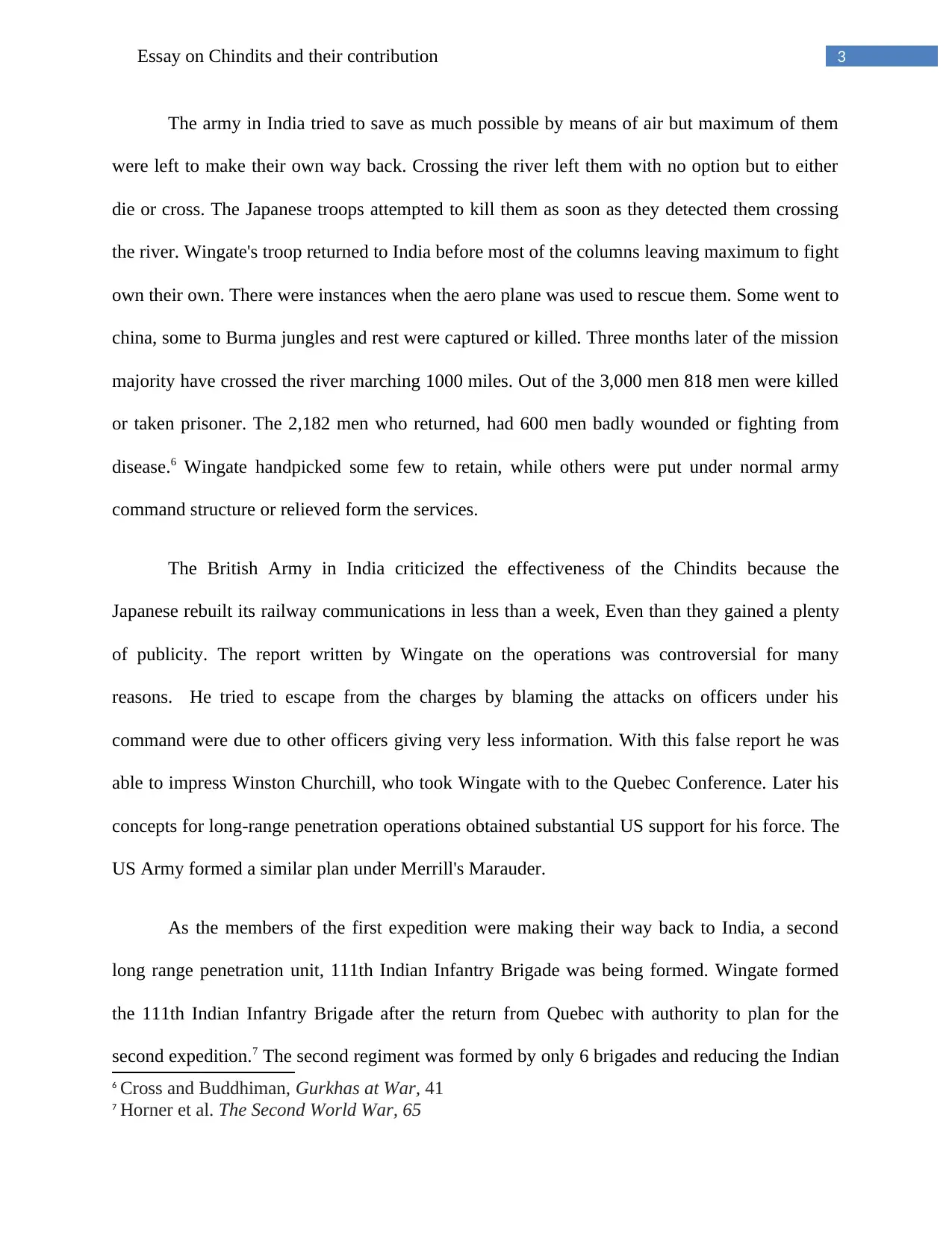
3Essay on Chindits and their contribution
The army in India tried to save as much possible by means of air but maximum of them
were left to make their own way back. Crossing the river left them with no option but to either
die or cross. The Japanese troops attempted to kill them as soon as they detected them crossing
the river. Wingate's troop returned to India before most of the columns leaving maximum to fight
own their own. There were instances when the aero plane was used to rescue them. Some went to
china, some to Burma jungles and rest were captured or killed. Three months later of the mission
majority have crossed the river marching 1000 miles. Out of the 3,000 men 818 men were killed
or taken prisoner. The 2,182 men who returned, had 600 men badly wounded or fighting from
disease.6 Wingate handpicked some few to retain, while others were put under normal army
command structure or relieved form the services.
The British Army in India criticized the effectiveness of the Chindits because the
Japanese rebuilt its railway communications in less than a week, Even than they gained a plenty
of publicity. The report written by Wingate on the operations was controversial for many
reasons. He tried to escape from the charges by blaming the attacks on officers under his
command were due to other officers giving very less information. With this false report he was
able to impress Winston Churchill, who took Wingate with to the Quebec Conference. Later his
concepts for long-range penetration operations obtained substantial US support for his force. The
US Army formed a similar plan under Merrill's Marauder.
As the members of the first expedition were making their way back to India, a second
long range penetration unit, 111th Indian Infantry Brigade was being formed. Wingate formed
the 111th Indian Infantry Brigade after the return from Quebec with authority to plan for the
second expedition.7 The second regiment was formed by only 6 brigades and reducing the Indian
6 Cross and Buddhiman, Gurkhas at War, 41
7 Horner et al. The Second World War, 65
The army in India tried to save as much possible by means of air but maximum of them
were left to make their own way back. Crossing the river left them with no option but to either
die or cross. The Japanese troops attempted to kill them as soon as they detected them crossing
the river. Wingate's troop returned to India before most of the columns leaving maximum to fight
own their own. There were instances when the aero plane was used to rescue them. Some went to
china, some to Burma jungles and rest were captured or killed. Three months later of the mission
majority have crossed the river marching 1000 miles. Out of the 3,000 men 818 men were killed
or taken prisoner. The 2,182 men who returned, had 600 men badly wounded or fighting from
disease.6 Wingate handpicked some few to retain, while others were put under normal army
command structure or relieved form the services.
The British Army in India criticized the effectiveness of the Chindits because the
Japanese rebuilt its railway communications in less than a week, Even than they gained a plenty
of publicity. The report written by Wingate on the operations was controversial for many
reasons. He tried to escape from the charges by blaming the attacks on officers under his
command were due to other officers giving very less information. With this false report he was
able to impress Winston Churchill, who took Wingate with to the Quebec Conference. Later his
concepts for long-range penetration operations obtained substantial US support for his force. The
US Army formed a similar plan under Merrill's Marauder.
As the members of the first expedition were making their way back to India, a second
long range penetration unit, 111th Indian Infantry Brigade was being formed. Wingate formed
the 111th Indian Infantry Brigade after the return from Quebec with authority to plan for the
second expedition.7 The second regiment was formed by only 6 brigades and reducing the Indian
6 Cross and Buddhiman, Gurkhas at War, 41
7 Horner et al. The Second World War, 65
Secure Best Marks with AI Grader
Need help grading? Try our AI Grader for instant feedback on your assignments.
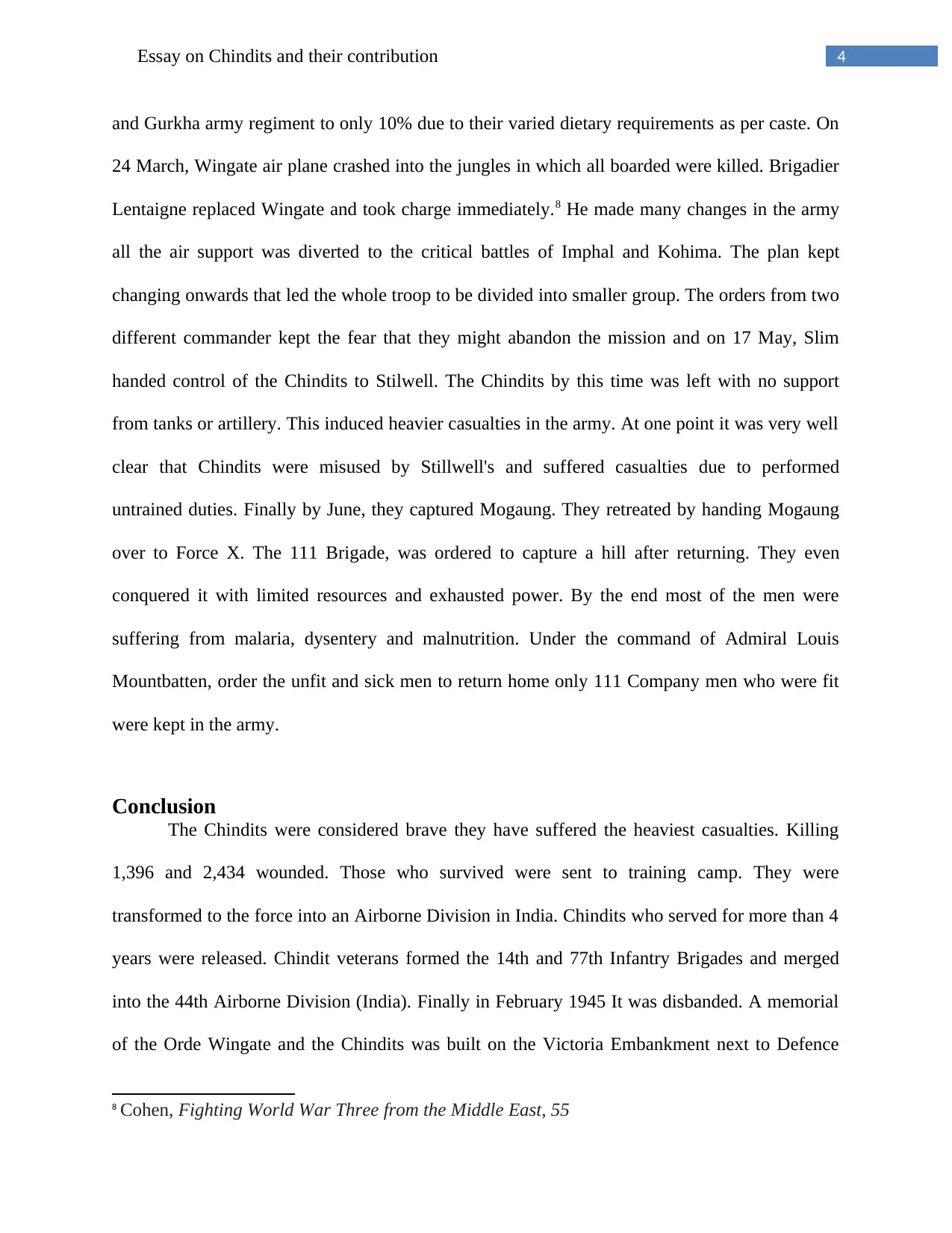
4Essay on Chindits and their contribution
and Gurkha army regiment to only 10% due to their varied dietary requirements as per caste. On
24 March, Wingate air plane crashed into the jungles in which all boarded were killed. Brigadier
Lentaigne replaced Wingate and took charge immediately.8 He made many changes in the army
all the air support was diverted to the critical battles of Imphal and Kohima. The plan kept
changing onwards that led the whole troop to be divided into smaller group. The orders from two
different commander kept the fear that they might abandon the mission and on 17 May, Slim
handed control of the Chindits to Stilwell. The Chindits by this time was left with no support
from tanks or artillery. This induced heavier casualties in the army. At one point it was very well
clear that Chindits were misused by Stillwell's and suffered casualties due to performed
untrained duties. Finally by June, they captured Mogaung. They retreated by handing Mogaung
over to Force X. The 111 Brigade, was ordered to capture a hill after returning. They even
conquered it with limited resources and exhausted power. By the end most of the men were
suffering from malaria, dysentery and malnutrition. Under the command of Admiral Louis
Mountbatten, order the unfit and sick men to return home only 111 Company men who were fit
were kept in the army.
Conclusion
The Chindits were considered brave they have suffered the heaviest casualties. Killing
1,396 and 2,434 wounded. Those who survived were sent to training camp. They were
transformed to the force into an Airborne Division in India. Chindits who served for more than 4
years were released. Chindit veterans formed the 14th and 77th Infantry Brigades and merged
into the 44th Airborne Division (India). Finally in February 1945 It was disbanded. A memorial
of the Orde Wingate and the Chindits was built on the Victoria Embankment next to Defence
8 Cohen, Fighting World War Three from the Middle East, 55
and Gurkha army regiment to only 10% due to their varied dietary requirements as per caste. On
24 March, Wingate air plane crashed into the jungles in which all boarded were killed. Brigadier
Lentaigne replaced Wingate and took charge immediately.8 He made many changes in the army
all the air support was diverted to the critical battles of Imphal and Kohima. The plan kept
changing onwards that led the whole troop to be divided into smaller group. The orders from two
different commander kept the fear that they might abandon the mission and on 17 May, Slim
handed control of the Chindits to Stilwell. The Chindits by this time was left with no support
from tanks or artillery. This induced heavier casualties in the army. At one point it was very well
clear that Chindits were misused by Stillwell's and suffered casualties due to performed
untrained duties. Finally by June, they captured Mogaung. They retreated by handing Mogaung
over to Force X. The 111 Brigade, was ordered to capture a hill after returning. They even
conquered it with limited resources and exhausted power. By the end most of the men were
suffering from malaria, dysentery and malnutrition. Under the command of Admiral Louis
Mountbatten, order the unfit and sick men to return home only 111 Company men who were fit
were kept in the army.
Conclusion
The Chindits were considered brave they have suffered the heaviest casualties. Killing
1,396 and 2,434 wounded. Those who survived were sent to training camp. They were
transformed to the force into an Airborne Division in India. Chindits who served for more than 4
years were released. Chindit veterans formed the 14th and 77th Infantry Brigades and merged
into the 44th Airborne Division (India). Finally in February 1945 It was disbanded. A memorial
of the Orde Wingate and the Chindits was built on the Victoria Embankment next to Defence
8 Cohen, Fighting World War Three from the Middle East, 55
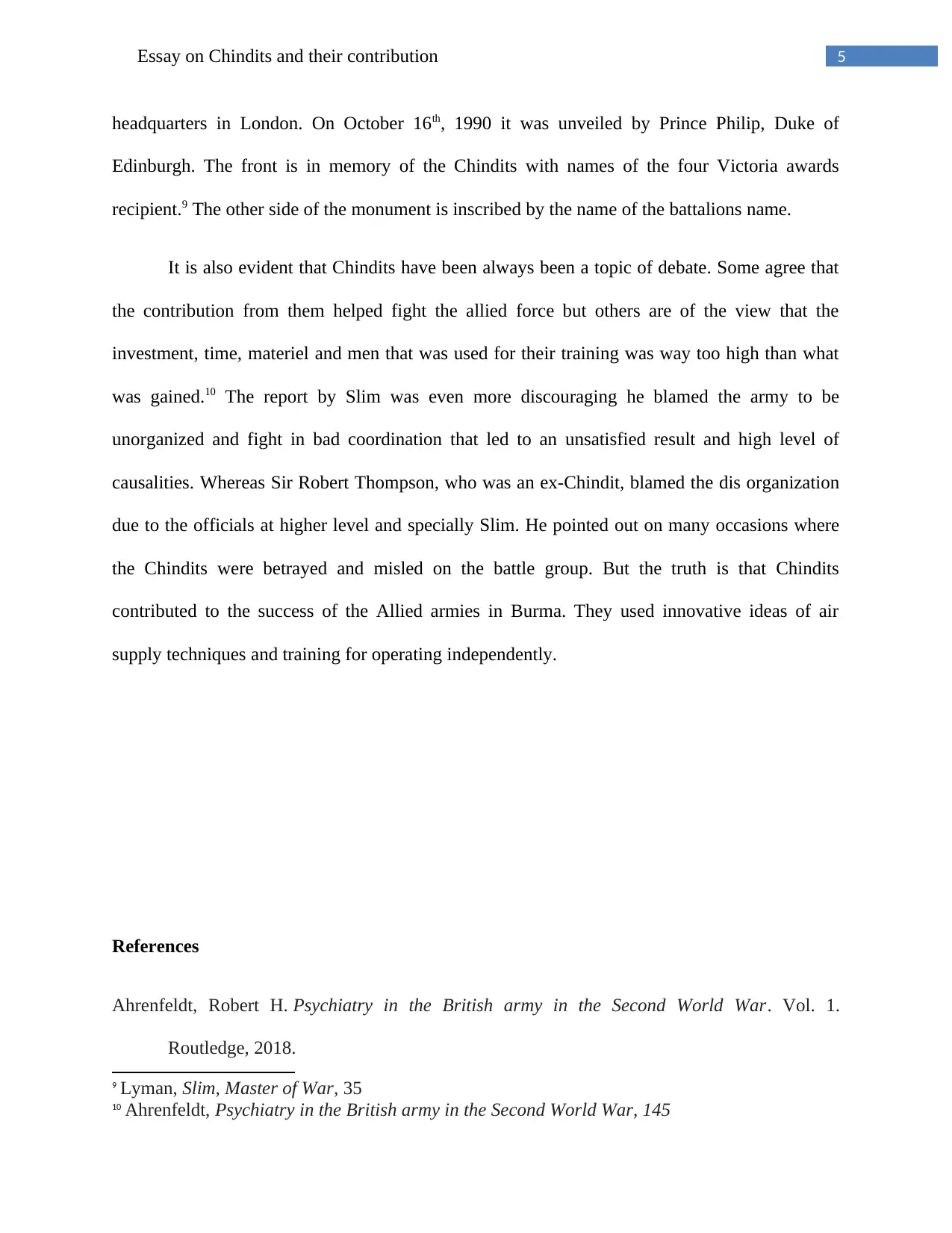
5Essay on Chindits and their contribution
headquarters in London. On October 16th, 1990 it was unveiled by Prince Philip, Duke of
Edinburgh. The front is in memory of the Chindits with names of the four Victoria awards
recipient.9 The other side of the monument is inscribed by the name of the battalions name.
It is also evident that Chindits have been always been a topic of debate. Some agree that
the contribution from them helped fight the allied force but others are of the view that the
investment, time, materiel and men that was used for their training was way too high than what
was gained.10 The report by Slim was even more discouraging he blamed the army to be
unorganized and fight in bad coordination that led to an unsatisfied result and high level of
causalities. Whereas Sir Robert Thompson, who was an ex-Chindit, blamed the dis organization
due to the officials at higher level and specially Slim. He pointed out on many occasions where
the Chindits were betrayed and misled on the battle group. But the truth is that Chindits
contributed to the success of the Allied armies in Burma. They used innovative ideas of air
supply techniques and training for operating independently.
References
Ahrenfeldt, Robert H. Psychiatry in the British army in the Second World War. Vol. 1.
Routledge, 2018.
9 Lyman, Slim, Master of War, 35
10 Ahrenfeldt, Psychiatry in the British army in the Second World War, 145
headquarters in London. On October 16th, 1990 it was unveiled by Prince Philip, Duke of
Edinburgh. The front is in memory of the Chindits with names of the four Victoria awards
recipient.9 The other side of the monument is inscribed by the name of the battalions name.
It is also evident that Chindits have been always been a topic of debate. Some agree that
the contribution from them helped fight the allied force but others are of the view that the
investment, time, materiel and men that was used for their training was way too high than what
was gained.10 The report by Slim was even more discouraging he blamed the army to be
unorganized and fight in bad coordination that led to an unsatisfied result and high level of
causalities. Whereas Sir Robert Thompson, who was an ex-Chindit, blamed the dis organization
due to the officials at higher level and specially Slim. He pointed out on many occasions where
the Chindits were betrayed and misled on the battle group. But the truth is that Chindits
contributed to the success of the Allied armies in Burma. They used innovative ideas of air
supply techniques and training for operating independently.
References
Ahrenfeldt, Robert H. Psychiatry in the British army in the Second World War. Vol. 1.
Routledge, 2018.
9 Lyman, Slim, Master of War, 35
10 Ahrenfeldt, Psychiatry in the British army in the Second World War, 145
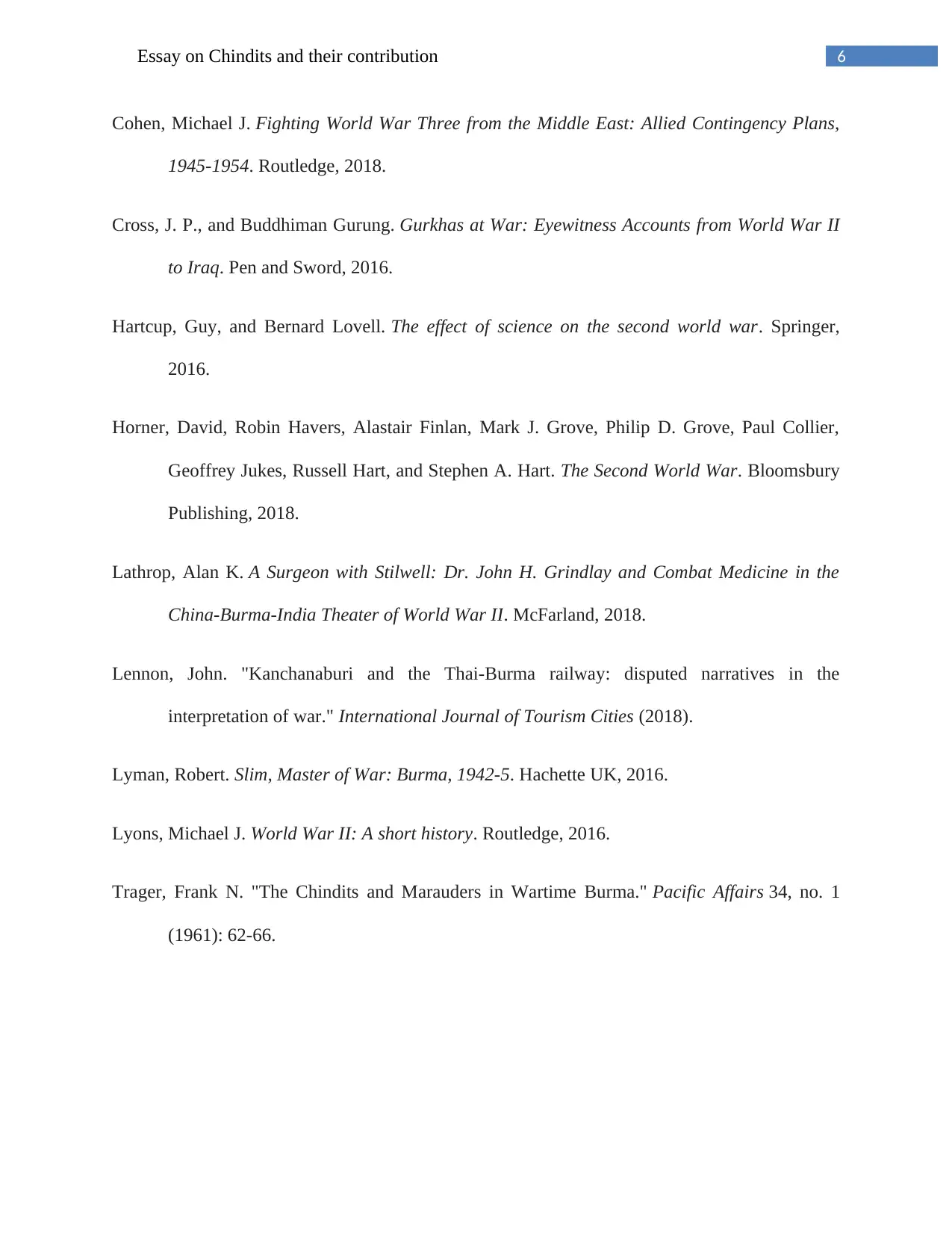
6Essay on Chindits and their contribution
Cohen, Michael J. Fighting World War Three from the Middle East: Allied Contingency Plans,
1945-1954. Routledge, 2018.
Cross, J. P., and Buddhiman Gurung. Gurkhas at War: Eyewitness Accounts from World War II
to Iraq. Pen and Sword, 2016.
Hartcup, Guy, and Bernard Lovell. The effect of science on the second world war. Springer,
2016.
Horner, David, Robin Havers, Alastair Finlan, Mark J. Grove, Philip D. Grove, Paul Collier,
Geoffrey Jukes, Russell Hart, and Stephen A. Hart. The Second World War. Bloomsbury
Publishing, 2018.
Lathrop, Alan K. A Surgeon with Stilwell: Dr. John H. Grindlay and Combat Medicine in the
China-Burma-India Theater of World War II. McFarland, 2018.
Lennon, John. "Kanchanaburi and the Thai-Burma railway: disputed narratives in the
interpretation of war." International Journal of Tourism Cities (2018).
Lyman, Robert. Slim, Master of War: Burma, 1942-5. Hachette UK, 2016.
Lyons, Michael J. World War II: A short history. Routledge, 2016.
Trager, Frank N. "The Chindits and Marauders in Wartime Burma." Pacific Affairs 34, no. 1
(1961): 62-66.
Cohen, Michael J. Fighting World War Three from the Middle East: Allied Contingency Plans,
1945-1954. Routledge, 2018.
Cross, J. P., and Buddhiman Gurung. Gurkhas at War: Eyewitness Accounts from World War II
to Iraq. Pen and Sword, 2016.
Hartcup, Guy, and Bernard Lovell. The effect of science on the second world war. Springer,
2016.
Horner, David, Robin Havers, Alastair Finlan, Mark J. Grove, Philip D. Grove, Paul Collier,
Geoffrey Jukes, Russell Hart, and Stephen A. Hart. The Second World War. Bloomsbury
Publishing, 2018.
Lathrop, Alan K. A Surgeon with Stilwell: Dr. John H. Grindlay and Combat Medicine in the
China-Burma-India Theater of World War II. McFarland, 2018.
Lennon, John. "Kanchanaburi and the Thai-Burma railway: disputed narratives in the
interpretation of war." International Journal of Tourism Cities (2018).
Lyman, Robert. Slim, Master of War: Burma, 1942-5. Hachette UK, 2016.
Lyons, Michael J. World War II: A short history. Routledge, 2016.
Trager, Frank N. "The Chindits and Marauders in Wartime Burma." Pacific Affairs 34, no. 1
(1961): 62-66.
1 out of 7
Related Documents
Your All-in-One AI-Powered Toolkit for Academic Success.
+13062052269
info@desklib.com
Available 24*7 on WhatsApp / Email
![[object Object]](/_next/static/media/star-bottom.7253800d.svg)
Unlock your academic potential
© 2024 | Zucol Services PVT LTD | All rights reserved.




